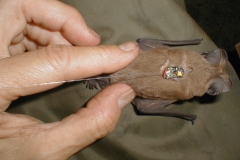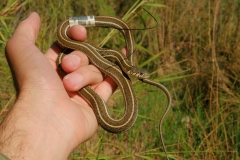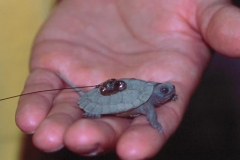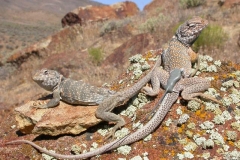This series of small transmitters is designed for glue-on application to bats, birds, herptiles and fish. Several harness and tail-mount configurations are available. The applications are limited only by the researchers’ ingenuity.
Specifications
| Model | Weight | Standard Life | Lifespan range | Dimensions: LxWxH (mm) |
|---|---|---|---|---|
| BD-2 | 0.62g | 3 weeks | 2-4 weeks | 14 x 6.5 x 3.5 |
| BD-2 | 0.75g | 4 weeks | 3-5 weeks | 14 x 6.5 x 3.5 |
| BD-2 | 0.90g | 6 weeks | 4-7 weeks | 15 x 7 x 3.5 |
| BD-2 | 1.2g | 7 weeks | 6-10 weeks | 16 x 8 x 3.5 |
| BD-2 | 1.4g | 9 weeks | 7-11 weeks | 17 x 8 x 4 |
| BD-2 | 1.6g | 11 weeks | 8-16 weeks | 18 x 10 x 3.5 |
| BD-2 | 1.8g | 14 weeks | 10-20 weeks | 17 x 8.5 x 5.5 |
Frequency Range: 138 – 235 MHz.
Transmitter: Crystal controlled two-stage design pulsed by a multivibrator.
Pulse Width (standard): 20 milliseconds.
Pulse Rate (standard): 40 pulses per minute (ppm). Available from 20-120ppm.
Power Output: Set to use available battery power over the required transmitter life.
Activation: Removing an external magnet starts the transmitter. Replacing the magnet stops the transmitter.
Antenna: A stranded stainless steel wire covered with a black or brown nylon coating, or a 0.18mm (0.007″) stainless steel wire. Shrinkable tubing can be added to reinforce the base of the antenna. Helical antennas can be added to allow for implantation (see photos below).
Housing: The transmitter and battery are encapsulated in an inert waterproof epoxy. Battery placement determines shape. Several mounting options are available (see below). Although the unit is usually glued to the animal (click here for gluing instructions), one or two tubes can be attached for the passage of sutures or harness material (click here for harnessing instructions). Tubes will increase the total weight by 0.05 to 0.1 g. The unit can be attached to a bird leg-band (supplied by researcher). Extra potting is required for implanted transmitters, for use in high ionic environments (e.g. alkaline, saline), for extra waterproofing, or for abrasion resistance where needed. This will add ~0.1 g.
Examples of tube placement: Tubes will slightly increase length and weight (0.05 – 0.10g) of the finished transmitter.

One anterior tube for a light harness or belt.
One center tube for a light harness or belt.
Two tubes (anterior and posterior) for sutures or harness material.
Two pairs of vertical tubes and molded longitudinal groove for single feather tail-mount attachment.
Helical Antenna Configurations
All of the sizes listed above can be fitted with helical antennas to allow for implantation. This will add ~0.1g to the finished weight and 2mm to the height (Internal Helix) or 10mm to the length (External Helix). Please note: Due to the reduction in reception range, this configuration should only be used in cases where a subcutaneous antenna is not possible. There are two available options:
 Internal Helix (suffix “H”): In this configuration, the helical antenna is placed across the top of the unit and encapsulated within the potting material. Range under normal conditions: 50-100m.
Internal Helix (suffix “H”): In this configuration, the helical antenna is placed across the top of the unit and encapsulated within the potting material. Range under normal conditions: 50-100m.
External Helix (suffix “HX”): In this configuration, the helical antenna is coiled around a 10mm piece of Tygon tubing, which extends beyond the back of the unit. Range under normal conditions: 100 – 200m.
Options
Temperature (suffix “T”): An increase or decrease in temperature results in a corresponding increase or decrease in pulse rate. At the standard settings, the pulse rate changes from ~25 ppm at 0°C to ~40 ppm at 40°C. Each transmitter is supplied with a plotted calibration curve. This option adds ~0.05g to the finished weight of the transmitter.
Position (suffix “P”): The pulse rate switches from ~24 ppm in a vertical position to ~50 ppm in a horizontal position. This option adds ~0.5g to the finished weight of the transmitter.
Photos
Videos
Radio transmitting Mt. Yellow-Legged Frogs – Vets in the Wild West – BBC
















